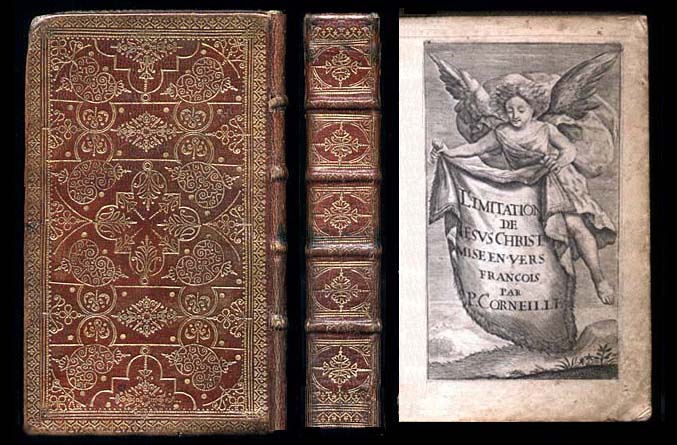

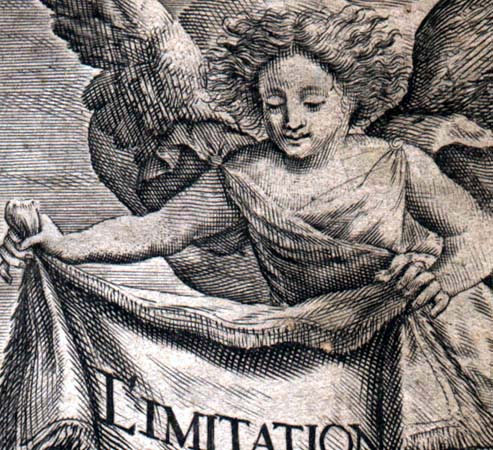
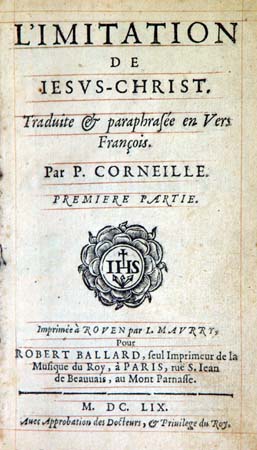
|
L'imitation de Jésus-Christ. Traduite et paraphrasée en vers françois. Par P. Corneille Première partie. Imprimée à Rouen par L. Maurry, pour Robert Ballard, seul imprimeur de la musique du roy, à Paris, 1659. (printed in Rouen, by L. Maurry, for Robert Ballard, unique printer of the King's Music, in Paris 1659) Tome 1 (sur 2), contenant les trois premières parties. (First volume of 2, containing the first three parts) Reliure éditeur, maroquin rouge, 15 x 9 cm, plats ornés, dos à nerfs orné et doré, tranches dorées, frontispiece gravé, 416 p., (contemporary binding, red maroquin, 15 x 9 cm, decorative binding, by Antoine Ruette, all edges gilt, engraved frontispiece, 416 pages) click here see more details about this binding Avec 68 gravures pleine page, la plupart signées H. David. (with 68 full page engravings, most bearing the signature of "H. David" which is a monogram) |
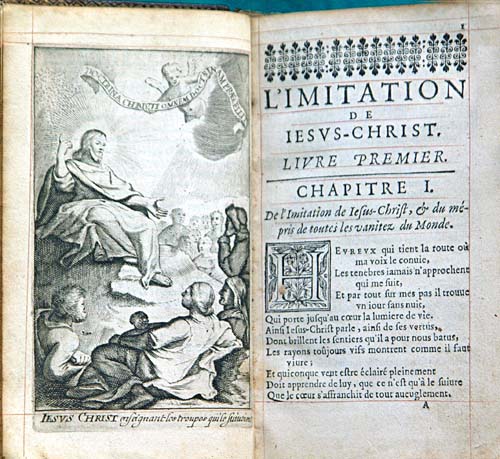
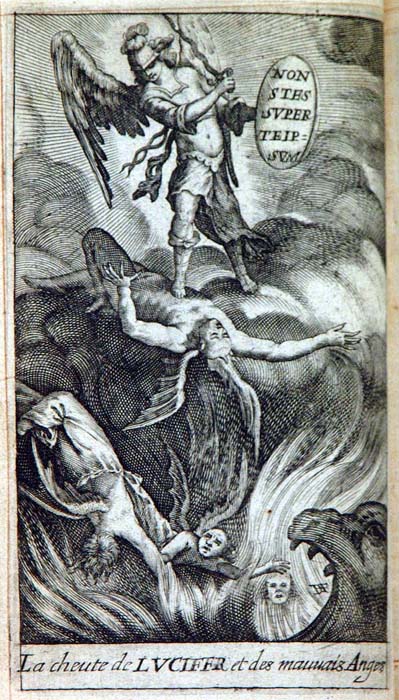
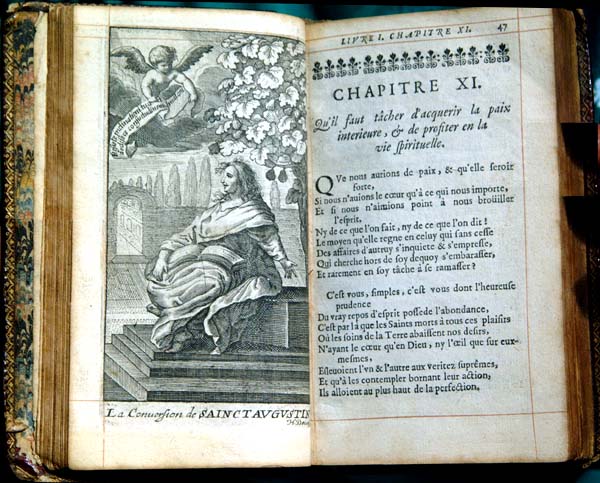
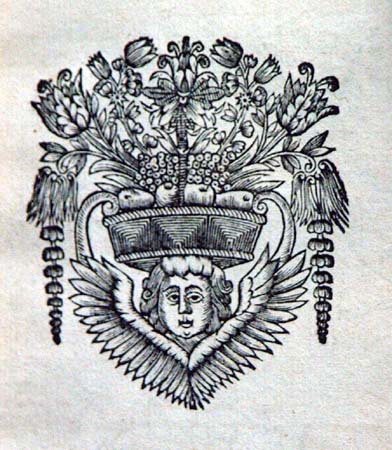
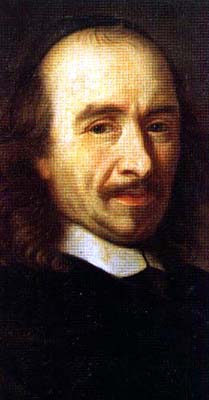
|
Pierre Corneille (June 6, 1606 - October 1, 1684) was a French tragedian who was one of the three great dramatists produced by France during the 17th century, along with Molière and Racine.
Corneille was born at Rouen, and studied law. He then practiced law for 21 years, meanwhile writing 20 plays. Corneille was elected to the French Academy in 1647. After "Pertharite" (1653), which was a decided failure, he resolved to quit the stage, and in his retreat at Rouen began to translate the "Imitation of Christ" at the solicitation of Queen Anne of Austria. En 1651, Corneille essuya un é chec suite à la représentation de "Pertharite", et son humeur mélancolique et brusque le fit se décourager et penser qu'il é tait trop âgé pour le thé âtre et voulant l'abandonner, il se tourna donc vers la religion. Ainsi, les jé suites lui demandèrent de traduire "l'Imitation de Jésus-Christ". Une autre version indiquerait que le Chancelier Séguier, indigné par la pièce de Corneille, "L'Occasion perdue et recouvré e", pièce qui fit scandale, lui aurait demandé de se confesser au Révérend Père du couvent de Nazareth dont le Chancelier Séguier était fondateur. Le Révérend ayant absous Corneille, lui aurait donné comme pénitence de traduire "L'Imitation de Jèsus-Christ". Courant de l'anné e 1651, Pierre Corneille fit publier sa traduction des vingt premiers chapitres de "l'Imitation de Jésus-Christ". Cette première partie ayant un tel succès, fut réimprimé e trente-deux fois et incita Corneille à continuer. Sa pièce "Andromède" fut é galement imprimé e au cours de cette même année. En 1652, il fit paraître la seconde partie de sa traduction de "l'Imitation de Jésus-Christ" à la demande de la Reine Mère, Anne d'Autriche, admirative de la premi¸re partie. En 1653, il fit paraître la troisième partie, suite à une grave maladie qui failli l'emporter. En 1654, parut la quatrième partie. En 1656, parut la cinquième et dernière partie de sa traduction de "L'Imitation de Jésus-Christ". En 1658, la mère de Corneille, Marthe Le Pesant de Bois-Guilbert, mourut à Rouen. En cette même année, Pierre Corneille composa des stances "Marquise", dédiés à la Marquise du Parc, qui refusa ses avances. Il nommait de temps à autre ses stances "Iris" au lieu de "Marquise". Le 24 janvier 1659, Pierre Corneille célébra la première représentation de sa nouvelle tragédie "Oedipe", au Thé âtre de l'Hôtel de Bourgogne, celle-ci fut un nouveau grand succès. En 1660, Corneille s'allia avec le Marquis de Sourdéac pour composer une tragé die "La Toison d'Or" en célébration du mariage de Louis XIV et de Marie-Thérèse d'Autriche. Le Marquis de Sourdéac organisa une somptueuse fête en son château de Neubourg en Normandie et la tragédie y fut interprétée par les Comédiens du Marais. http://17emesiecle.free.fr/Corneille.php Imitation of Christ |
|
"The Imitation of Christ (or De imitatione Christi), by Thomas à Kempis is one of the most widely read Christian spiritual books in existence. It was first published anonymously, in Latin, ca. 1418; several other authors have been proposed, but Kempis's authorship is now generally accepted. Imitation of Christ is considered the pearl of all the writings of the mystical German-Dutch school of the fourteenth and fifteenth centuries, and with the "Confessions" of Augustine and John Bunyan's Pilgrim's Progress it occupies a front rank, if not the foremost place, among useful manuals of devotion, after the Bible. Protestants and Roman Catholics alike join in giving it praise. The Jesuits give it an official place among their "exercises". John Wesley and John Newton put it among the works that influenced them at their conversion. General Gordon carried it with him to the battlefield. Few books have had so extensive a circulation. The number of counted editions exceeds 2,000; and 1,000 different editions are preserved in the British Museum. The Bullingen collection, donated to the city of Cologne in 1838, contained at the time 400 different editions. De Backer (Essai, ut inf.) enumerates 545 Latin and about 900 French editions. Originally written in Latin, a French translation was made as early as 1447, which still remains in manuscript. The first printed French copies appeared at Toulouse in 1488. The earliest German translation was made in 1434 by J. de Bellorivo and is preserved in Cologne. The editions in German began at Augsburg in 1486. The first English translation (1502) was by William Atkinson and Margaret Beaufort, mother of Henry VII, who did the fourth book. Translations appeared in Italian (Venice, 1488; Milan 1489), Spanish (Seville, 1536), Arabic (Rome, 1663), Armenian (Rome, 1674), Hebrew (Frankfort, 1837), and other languages. Pierre Corneille produced a poetical paraphrase in French in 1651. The Imitation of Christ derives its title from the heading of the first book, De imitatione Christi et contemptu omnium vanitatum mundi. It consists of four books and seems to have been written in meter and rhyme, a fact first announced by K. Hirsche in 1874. The four books are not found in all the manuscripts, nor are they arranged invariably in the same order. The work is a manual of devotion intended to help the soul in its communion with God and the pursuit of holiness. Its sentences are statements, not arguments, and are pitched in the highest key of Christian experience. It was meant for monastics and recluses. Behind and within all its reflections runs the counsel of self-renunciation. The life of Christ is presented as the highest study possible to a mortal. His teachings far excel all the teachings of the saints. The book gives counsels to read the Scriptures, statements about the uses of adversity, advice for submission to authority, warnings against temptation and how to resist it, reflections about death and the judgment, meditations upon the oblation of Christ, and admonitions to flee the vanities of the world. Christ himself is more than all the wisdom of the schools and lifts the mind to perceive more of eternal truth in a moment of time than a student might learn in the schools in ten years." |

| information about the author | return to the home page of VIRTUAL BOOKBINDING |